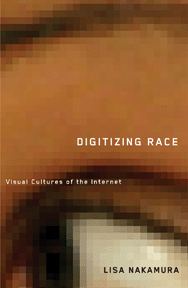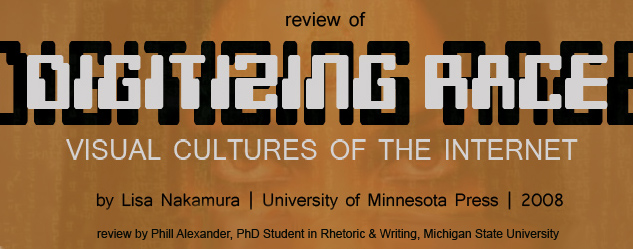

Introduction:
Digital Racial Formations
Chapter 1:
"Ramadan is Almoast Here"
Chapter 2:
Alllooksame
Chapter 3:
The Social Optics of Race
Chapter 4:
Avatars and Visual Culture
Chapter 5:
Measuring Race on the Internet
Epilogue:
Racio-Visual Logic
Visual Rhetoric in Digitizing Race
The introduction to Digitizing Race serves as a nicely condensed introduction to the idea of visual cultural studies. It is dense with review of existing literature, some of which is very familiar to digital rhetoricians (Manovich, Bolter and Grusin), some of which is somewhat familiar to rhetoric scholars (Stuart Hall) and some of which is likely new ground for many in our field (Rodowick, Fusco, and Sturken to name three). Nakamura’s introduction serves to do three primary things: Nakamura does a fantastic job of explaining her goals and rooting them in existing scholarship, providing a theoretically dense and well-contextualized foundation for the emerging field of visual cultural studies. She also offers an intriguing, engaging critique of the Lopez video and its use of Internet-familiar interfaces and tropes. It draws heavily from both film theory and the idea of the male gaze and from ideas of remediation and interface-as-gendered. The one problem that emerges in the introduction is that in places it becomes difficult to separate Nakamura’s critique of the Lopez video from the other work the introduction is meant to do. It could be reader bias due to expectations of genre, but at times it felt jarring to go from review of literature into fresh critique and then back. While all the included material is useful and engaging, as a reader I found myself wishing that the Lopez video had received its own chapter so that it could be pulled away from the work the introduction was doing. For readers who, like myself, are unfamiliar with visual cultural studies as a field, this introduction is invaluable as an introduction to that not-a-discipline and some of its foundational assumptions and methodologies.
|